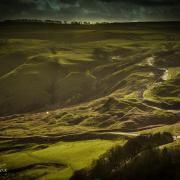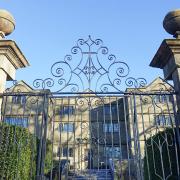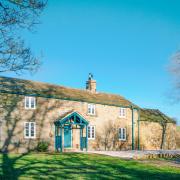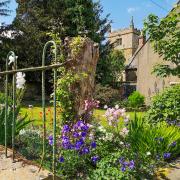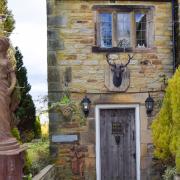The Derbyshire landscape is peppered with ancient standing stones and stone circles.
The meaning behind their construction has become lost to us over time, but they have an apparent ritualistic function, and have consequently acquired a degree of associated folklore.
Arbor Low stone circle, located between Monyash and Youlgrave, has been called the ‘Stonehenge of the North’.
With its 50 limestone slabs laying in a circular arrangement, the monument has also been described as resembling a giant clock face when viewed from above, although debate continues amongst archaeologists as to whether the stones of Abor Low were originally constructed lying flat, or whether they have at some point in time toppled over or even been deliberately pushed – perhaps by the zealous hand of someone with differing religious beliefs to the builders of the circle.

It is thought Christianity was introduced to the UK from the year 200 AD onwards. However, the older, nature-venerating pagan religious ways practiced by earlier inhabitants of the British Isles proved hard to stamp out, especially in remote rural areas.
Over the course of the first millennium a series of symposiums were held for policymakers of the Christian church. A running theme throughout these were attempts to vanquish persistent animistic beliefs.
In 452, the Council of Arles forbade the worship of stones; in 567 the Council of Tours ordered that those who worship stones be excommunicated; and in 658 the Council of Nantes decreed bishops should dig up monumental stones.
Whilst it does not attract anywhere near as much ritual focus as Stonehenge, the fact that people congregate at Arbor Low at Summer and Winter Solstice and regularly leave ‘offerings’ comprising deposits of natural materials on the stones suggests similar beliefs continue into the 21st Century.
More theatrically, on a damp June day in 1927, a bunch of white and black robed druids led by the eccentric Ralph de Tunstall Sneyd - who was attempting to revive druidism as a practiced religion - descended on Arbor Low to perform a mystic ceremony.
Six miles away, Stanton Moor and its environs contain a wealth of prehistoric remains, the most well-known being the Nine Ladies stone circle.

The past 40 years have seen an increasing number of visitors descending on this site, most notably around the Summer Solstice.
The often competing and clashing desires of the landowner, locals, tourists, the Peak District National Park Authority and pagans is explored in Amy Blease-Bourne’s PhD thesis, published in book form as Guarding Sacred Sites.
Blease-Bourne is a former member of the long-running protest camp established by eco-warriors that was present on the edge of the moor between 1999-2010, with the ultimately successful aim of preventing proposed further quarrying within range of the ancient monuments, a different nearby site being granted permission as a compromise.
According to local legend (which resembles similar folktales concerning stone circles elsewhere in the UK), the Nine Ladies stone circle is supposed to have been formed by nine carousing local lasses who insisted on dancing on the moor upon a forbidden day (either the Sabbath or midsummer, depending on the version) and were consequently turned to stone as punishment for their transgression, alongside an outlying stone known as the King or Fiddler Stone, who is the petrified form of the fiddle player egging them on (in some tellings, the fiddler is the Devil).

Just outside the moor is Birchover village, and behind the mystically named local, the Druid Inn, is found Rowtor Rocks. These rocks are a jumble of whimsical features incorporating prehistoric cup and ring artwork, sculpted ‘armchairs’, steps and caves.
The whole assemblage is said to be largely the fanciful work of Reverend Thomas Eyre, rector of the village in the 17th Century, reported to enjoy a sideline in witchcraft and consequently attracted to his position by the area’s longstanding pagan connotations.
Close by on Harthill Moor is the Nine Stones Close stone circle (of which only four stones remain, a fifth incorporated into a nearby wall), also known as the Grey Ladies.
It is a similar story to up the road at Stanton Moor, but in reverse: instead of the stones being female dancers petrified, here the stones are said to come to life and dance when they feel like doing so.
Wayne Anthony in Haunted Derbyshire records a smorgasbord of spectres and physic phenomena reported from the vicinity of Nine Stones Close: fairies, strange blue lights, phantom monks, headless horsemen, green men, witchcraft and devil worship.

Another formerly rich area for stone monuments is identified by Stephen Bailey in The Old Roads of Derbyshire: ‘Between Matlock and Chesterfield there is a group of lanes with ‘stone’ names: Hearthstone Lane, Cuckoostone Lane, Wirestone Lane, Holestone Lane, Shuckstone Lane. The only surviving stone appears to be the Cuckoo Stone, now located on the Matlock Golf Club course, so presumably the others were broken up at some point. The names suggest that, in the pre-enclosure period, when this area formed part of East Moor, these stones were significant features in the landscape’.
Matlock Golf Club was formed in 1906 to appeal to the middle-class clientele who at the time flocked to Matlock to visit the town’s hydropathic hotels.
The presence of the Cuckoostone on its course is embraced by the club, the stone’s image being reproduced as the club’s logo on ties and polo shirts sported by members.
The Cuckoostone is supposed to turn around at the sound of a cockerel crowing - a common legend ascribed to various ancient stones located throughout the British Isles.
A farming correspondent for the Derbyshire Courier newspaper, clearly in possession of a lively imagination, suggested in 1911, ‘The original purpose of the stone is lost in the mists of antiquity, but, remembering the existence at [Matlock suburb] Riber of stones of undeniably Druidical origin, it may very reasonably be conjectured that the Cuckoostone was formerly a sacrificial altar … it is more than probable that the sheltered slopes now devoted to the absorbing but peaceful pursuit of golf were once the scene of dread processions of white-robed priests, drowning the cries of the victims with beat of drum and chant of hymn’.

Close by the golf club, at Lumsdale, is found Matlock’s Wishing Stone. Wayne Anthony in Haunted Derbyshire explains how this mystical boulder operates: ‘Many people journeyed to the stone in the hope of having a wish granted, for it was believed that a nature spirit dwelt in the rock. To entice the spirit to favour your request, it was necessary to perform the small ritual of walking around the rock three times, each time repeating under your breath the desired wish. It was further held that you could wish for anything you like as long as it was not money or material gain. If the nature spirit favoured your request your wish was sure to come true within the next three lunar cycles’.
Other sources stipulate circumnavigating the rock nine times (although its surroundings are nowadays so overgrown, getting round it once would prove an achievement), or leaving a monetary gift upon the stone.
Another stone with magical properties in this stretch of Derbyshire between Matlock and Chesterfield is the Faybrick, or Fabric, Rock at Ashover.
According to Victorian folklorist S. O. Addy, if you simply sit on this stone and wish three times your wishes will also be granted.
Buxton Museum are the current custodians of the Mouselow Stones. These stones of indeterminate date period carved with a variety of unusual symbols (one seemingly depicting a horned Devil-like figure) were formerly on display, incorporated into an archway, but after the Museum’s Wonders of the Peak gallery was revamped in 2017, the majority of the stones are now kept in the museum store.
The stones were first discovered in 1840 at Mouselow Hill in Glossop by Reverend George Marsden, who took a fancy to them and incorporated them into his house at Hadfield.
Following intervention from the Duke of Norfolk they were removed and transferred to the custodianship of the Glossop Antiquarian Society, but this group disbanded in 1939 upon the outbreak of war and the stones subsequently languished in a cellar, forgotten for much of the 20th Century.
Further excavations took place at Mouselow in 1965, but it was when archaeologist Glynis Reeve entered the scene to conduct further work at the site 19 years later that things took a bizarre turn.
Not long after they began work on site, Glynis and her team of volunteer diggers from the University of Manchester were subjected to a series of anonymous phone calls from aggrieved locals asking why they were interfering with the site and muttering about disturbing the ‘Old Ways’.
When the Mouselow Stones were exhibited at a field centre associated with the dig in Glossop relations with local people soured further.
Volunteers working on the dig then began to suffer mysterious accidents on site. Computers and other electrical items stored in the same room as the stones went haywire and only became functional again once the stones were removed.
Harmony was finally restored after Glynis and a colleague scaled the summit of Mouselow Hill on the eve of Beltane, an important date in the pagan Celtic calendar, and proclaimed, ‘You have nothing to fear from us’.
The mysterious phone calls and mishaps subsequently stopped and the stones were transferred to Buxton Museum, where they have resided ever since without causing further mischief.
On Baslow Edge is a large standalone rock called The Eagle Stone. It is thought to have acquired the name either because eagles formerly nested upon it, or as a corruption of Aigle’s Stone – Aigle being a giant and a pagan god with a penchant for throwing large rocks around.
It used to be the custom for the menfolk of Baslow to scale this rock in order to prove they were suitable material for marriage. S. O. Addy says that this rock also rotates when it hears the cock crow.
These are a small selection of Derbyshire’s standing stones and stone circles, chosen for their associated folklore and traditions.
There are many other such sites across the county, and we are lucky to have so many remaining ancient monuments as a tangible link to our distant ancestors.
Part of their charm and mystery is the fact we can never really know for what purpose they were constructed; suggestions range from marketplaces to astronomical observatories, but this is all ultimately conjecture.
As amateur archaeologist and local sub postmaster J. Percy Heathcote observed in his 1947 guidebook to Birchover and its prehistoric remains: ‘We cannot therefore dismiss prehistoric man as primitive, while we ourselves are ignorant of the purposes of his [sic] ancient monuments’.








